2nd degree heart block - Study guides, Class notes & Summaries
Looking for the best study guides, study notes and summaries about 2nd degree heart block? On this page you'll find 1215 study documents about 2nd degree heart block.
Page 3 out of 1.215 results
Sort by
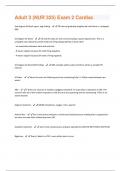
-
Adult 3 (NUR 325) Exam 2 Cardiac Questions & Answers Already Passed!!
- Exam (elaborations) • 14 pages • 2024
- Available in package deal
-
- $7.99
- + learn more
2nd degree AV block type 1 ekg finding - PR interval gradually lengthened until there is a dropped QRS 3rd degree AV block - SA and AV node are not communicating. Causes hypotension. This is a complete heart block SA and AV node are firing independently of each other - no association between atria and ventricle - R waves regular because AV node firing regularly - P waves regular because SA node is firing regularly 3rd degree AV block EKG finding - QRS complex will be wide and there will b...
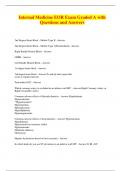
-
Internal Medicine EOR Exam Graded A with Questions and Answers
- Exam (elaborations) • 27 pages • 2024
-
- $12.24
- + learn more
2nd Degree Heart Block - Mobitz Type II - Answer 2nd Degree Heart Block - Mobitz Type I [Wenchebach] - Answer Right Bundle Branch Block - Answer LBBB - Answer Left Bundle Branch Block - Answer 1st degree heart block - Answer 3rd degree heart block - Answer Ps and Qs don't agree But occur at regular intervals Pericarditis ECG - Answer
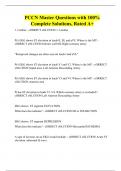
-
PCCN Master Questions with 100% Complete Solutions, Rated A+
- Exam (elaborations) • 40 pages • 2024
-
- $13.99
- + learn more
1. Cardiac - cORRECT sOLUTION 1. Cardiac Pt's EKG shows ST elevation in leads II, III, and aVF. Where is the MI? - cORRECT sOLUTION Inferior wall MI, Right coronary artery "Reciprocal changes are often seen ini leads I and aVL" Pt's EKG shows ST elevation in leads V1 and V2. Where is the MI? - cORRECT sOLUTION Septal area, Left Anterior Descending Artery Pt's EKG shows ST elevation in leads V3 and V4. Where is the MI? - cORRECT sOLUTION Anterior area Pt has ST elevation in le...
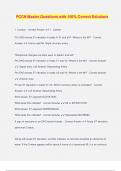
-
PCCN Master Questions with 100% Correct Solutions
- Exam (elaborations) • 42 pages • 2024
- Available in package deal
-
- $13.49
- + learn more
PCCN Master Questions with 100% Correct Solutions 1. Cardiac - Correct Answer ️️ -1. Cardiac Pt's EKG shows ST elevation in leads II, III, and aVF. Where is the MI? - Correct Answer ️️ -Inferior wall MI, Right coronary artery "Reciprocal changes are often seen ini leads I and aVL" Pt's EKG shows ST elevation in leads V1 and V2. Where is the MI? - Correct Answer ️️ -Septal area, Left Anterior Descending Artery Pt's EKG shows ST elevation in leads V3 and V4. Where is the MI...
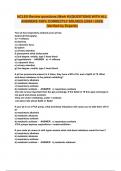
-
NCLEX Review questions (Mark K){QUESTIONS WITH ALL ANSWERS 100% CORRECTLY SOLVED} (2024 / 2025) (Verified by Experts)
- Exam (elaborations) • 58 pages • 2024
- Available in package deal
-
- $17.99
- + learn more
Your pt has respiratory acidosis your pt has: (select all that apply) a) +1 reflexes b) diarrhea c) a dynamic ileus d) spasm e) urinary retention f) paraxysmol atrial tachycardia e) 2nd degree, mobitz, type 2 heart block g) hypokalemia - ANSWER a) +1 reflexes c) a dynamic ileus e) urinary retention g) 2nd degree, mobitz, type 2 heart block A pt has pneumonia present in 4 lobes, they have a RR of 52, and a SpO2 of 78. What acid-base imbalance is the patient exhibiting? a) res...
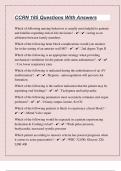
-
CCRN 185 Questions With Answers |Success Guaranteed |2025
- Exam (elaborations) • 25 pages • 2024
- Available in package deal
-
- $9.99
- + learn more
Which of following nursing behaviors is usually most helpful to patients and families regarding end-of-life decisions? - ️️acting as an arbitrator between family members. Which of the following heart block complications would you monitor for in the setting of an anterior wall MI? - ️️2nd degree Type II Which of the following is an appropriate strategy when providing mechanical ventilation for the patient with status asthmaticus? - ️️Use lower respiratory rates Which of the followi...
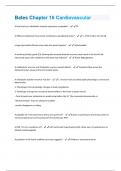
-
Bates Chapter 16 Cardiovascular Questions And Answers Graded A+
- Exam (elaborations) • 32 pages • 2024
- Available in package deal
-
- $7.99
- + learn more
A brief early to middiastolic impulse represents a palpable? - S3 A difference between these levels constitutes a paradoxical pulse? - >= 10mm Hg to 12 mm Hg a large pericardial effusion may make the apical impulse? - Undetectable A medium pitched, grade 2/4, blowing decrescendo diastolic murmur, best heard in the fourth left intercostal space with radiation to the Apex may indicate? - Aortic Regurgitation A middiastolic murmur and PreSystolic murmur would reflect? - Turbulent flow acros...

-
ACLS 2025 Final Exam Questions and Answers
- Exam (elaborations) • 17 pages • 2024
-
- $11.00
- + learn more
ACLS Tachycardia with a Pulse Algorithm Assess clinical condition Look for signs of increased work of breathing Look for signs of hypoxemia ACLS Bradycardia with a Pulse Algorithm Assess appropriateness for clinical condition Indentify and treat underlying cause. If no symptoms, monitor and observe. If symptoms, give Atropine Transcutaneous pacing, Dopamine, or Epinephrine Consider expert consultation, transvenous pacing Bradyarrhythmia is typically a rate of less than 50 beats per minute ...

-
NUR 425 Exam 1 Questions and Answers | Latest Update | 2024/2025 | Already Passed
- Exam (elaborations) • 78 pages • 2024
- Available in package deal
-
- $11.68
- + learn more
NUR 425 Exam 1 Questions and Answers | Latest Update | 2024/2025 | Already Passed 1st degree AV block -Prolonged PR interval -One QRS for every P wave -Same distance between each QRS, same distance between every P wave 2nd degree AV block (Type I: Wenkebach) -PR Intervals get progressively longer with each heart beat -QRS may drop (Longer, longer, longer, drop) 2nd degree AV block (Type II) -Heart beat occasionally loses QRS complex -Lonely P waves with no QRS 3rd degree AV ...
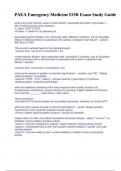
-
PAEA Emergency Medicine EOR Exam Study Guide.
- Exam (elaborations) • 110 pages • 2024
- Available in package deal
-
- $13.99
- + learn more
PAEA Emergency Medicine EOR Exam Study Guide. what is the most common cause of heart failure? specifically left sided? right sided? - - MC is CAD (coronary artery disease) -L sided: *CAD* & HTN -R sided: *L sided HF* & pulmonary dz decreased ejection fraction, thin ventricular walls, dilated LV chamber, and an S3 gallop (filling of dilated ventricle) is associated with systolic or diastolic heart failure? - systolic (MC form of CHF) *(the sound is actually heard in the diastole though) ...

Do you wonder why so many students wear nice clothes, have money to spare and enjoy tons of free time? Well, they sell on Stuvia! Imagine your study notes being downloaded a dozen times for $15 each. Every. Single. Day. Discover all about earning on Stuvia


